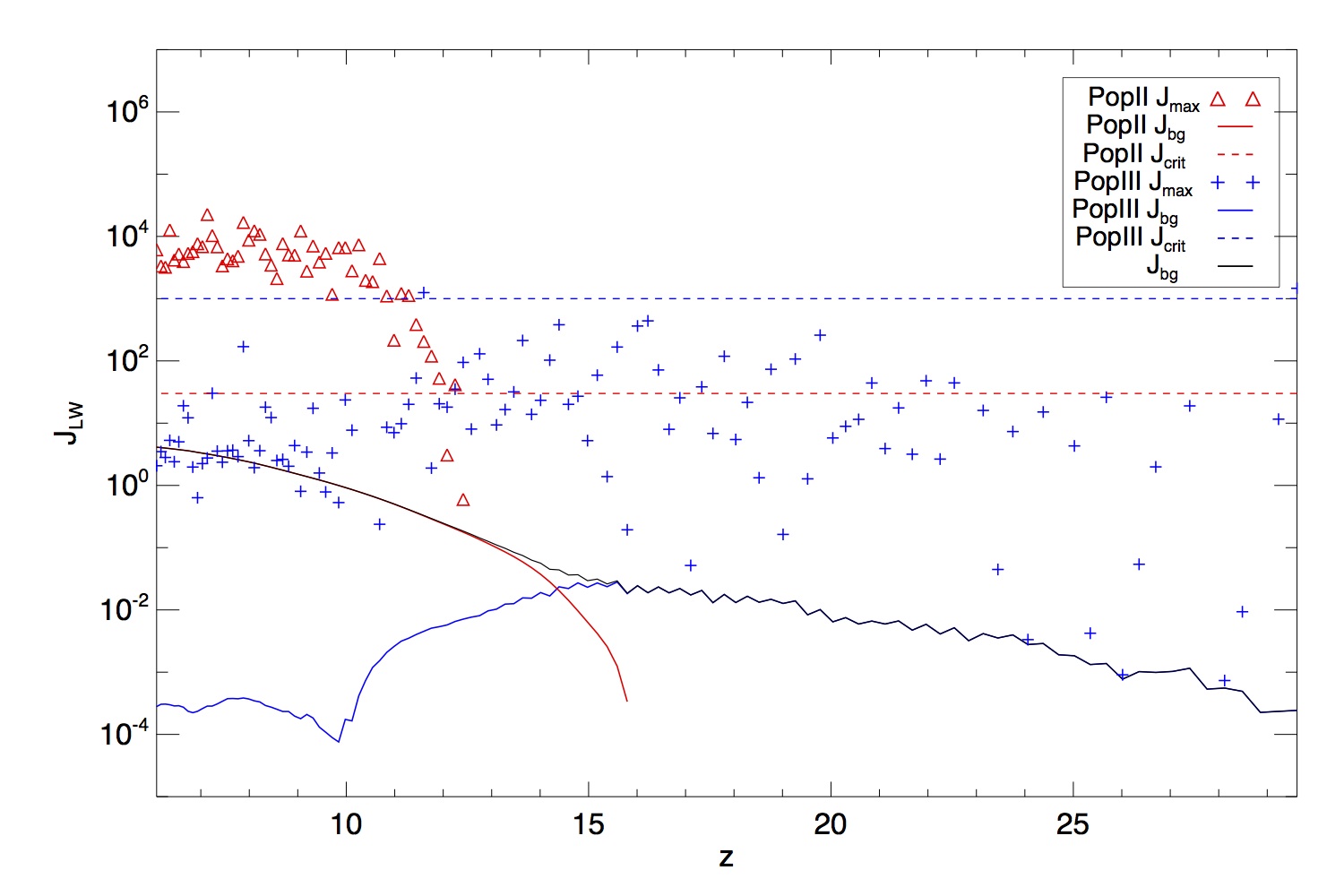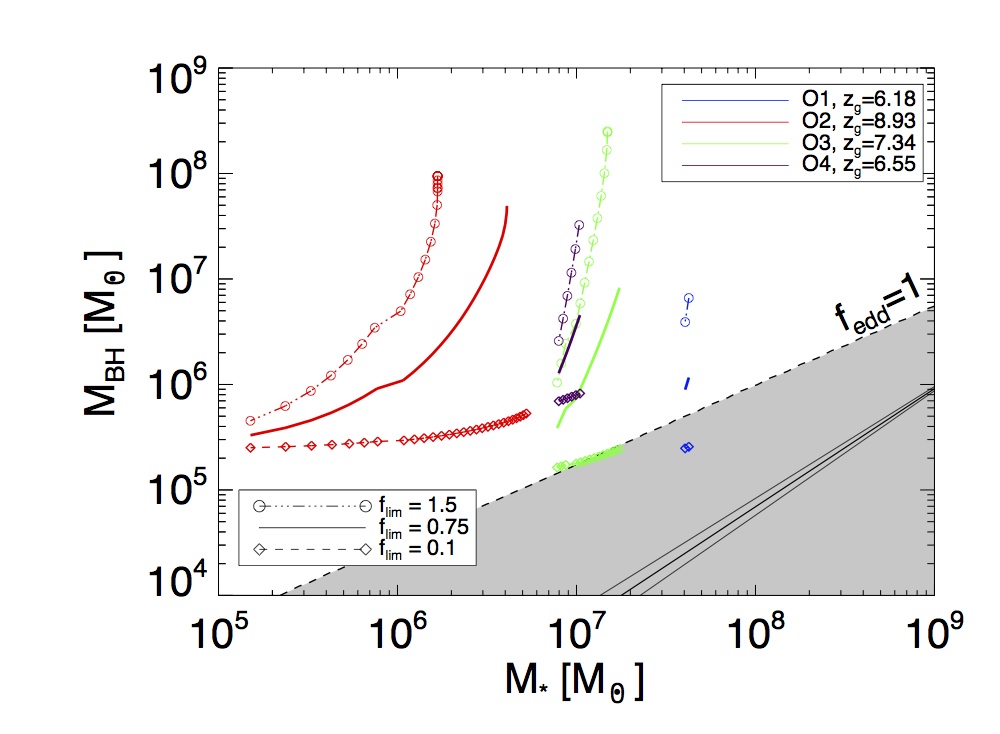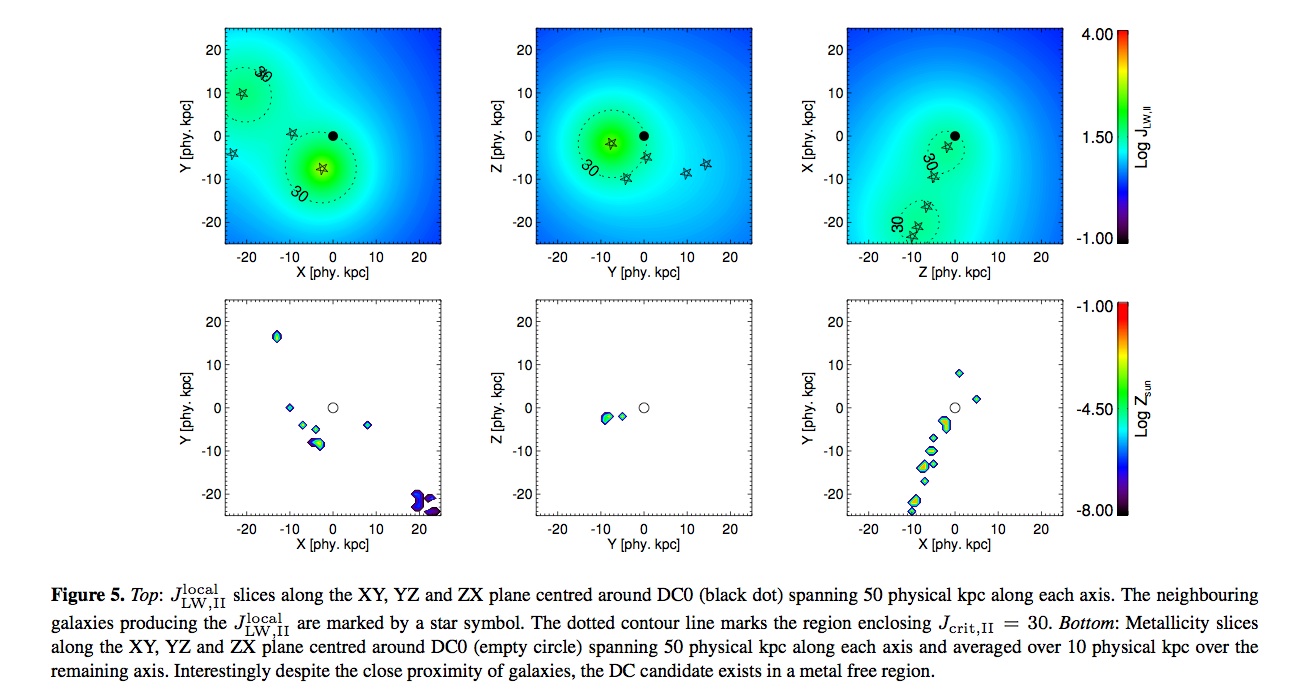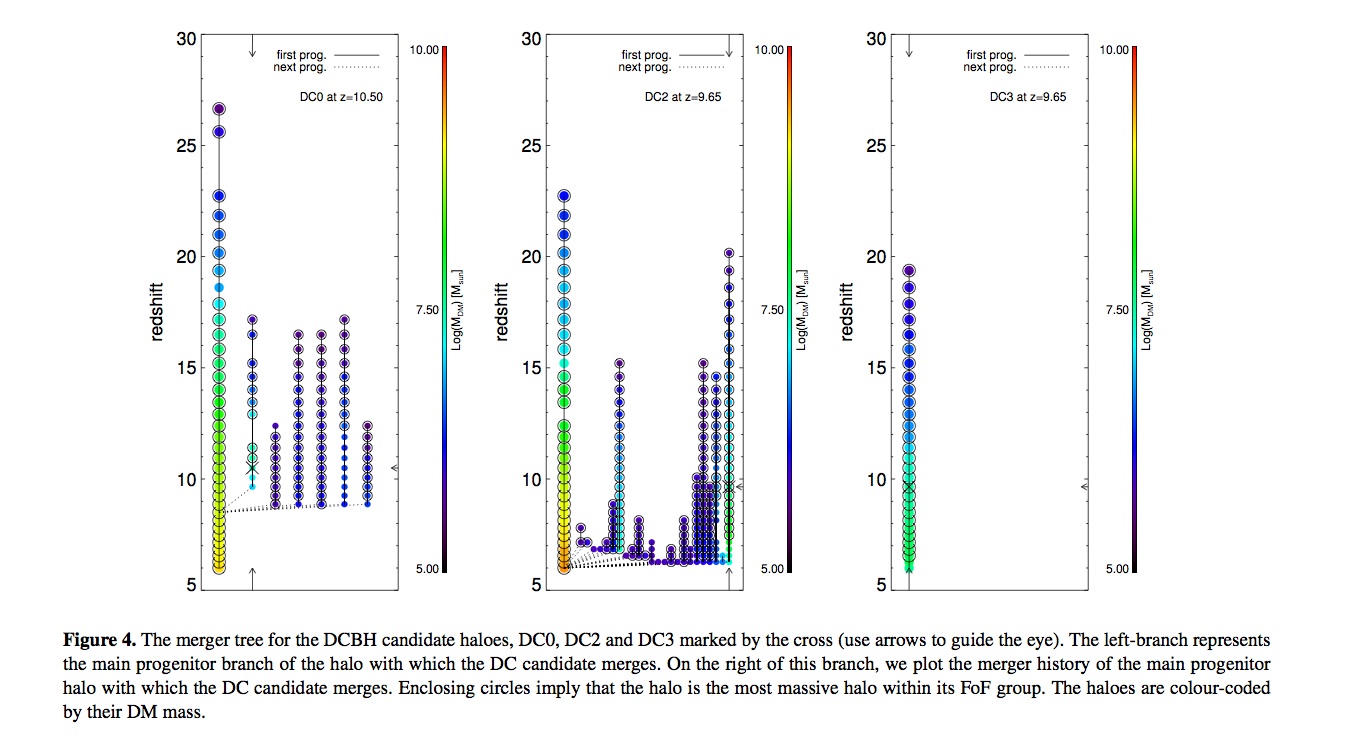There is no scientific consensus on how the seeds of the first supermassive black holes, already in place by z=7, formed. The two contrasting channels are the BH remnants (few hundred solar masses) of the Pop III stars or the massive BH seeds (10-100 thousand solar masses) that form out of the direct collapse of pristine gas. I have been working on models that explore the existence of direct collapse black holes, and I'm also interested in
- their impact on reionisation
- evolution to z=0
- local environment and where they end up: i.e. satellites or centrals

1. Plausibility of the direct collapse scenario
We developed a semi-analytical model (SAM) that can run on any merger-tree output from a given cosmological simulation and accounts for Pop III and Pop II star formation, the build up of the global Lyman-Werner (LW) background, the local variation of the LW specific intensity, reionisation feedback and the evolution of BH seeds.
In our study (published in MNRAS), where we tried to answer the question: How plausible is the direct collapse BH scenario?, we found numerous sties (namely pristine haloes) where the LW radiation intensity is high enough to critically shut down molecular hydrogen cooling, thereby preventing the gas from forming Pop III stars. These sites are potential candidates for DCBH formation. The sites were quite frequent with a number density close to 0.1 per cubic co-moving Mpc, much higher than previously estimated.
Fig. (above): The variation of the LW radiation. Global levels are indicated in solid and the maximum spatial level seen by a pristine halo at a given redshift is shown as triangles (Pop II) and crosses (Pop III).

2. Obese Black Hole galaxies
Having established the high plausibility of the DCBH scenario, it is clear that these objects must have been prevalent at z>6. We first explore the conditions under which a DCBH can form in the identified halo, given its virial temperature and spin. The galaxies which then allow the DCBHs to form are quite special, as in this case, the BH forms before the stars and is hence much more massive by the time star formation kicks in.
This leads to the question: What is the fate of the galaxies in which these DCBHs reside?
We coin the termObese Black-hole Galaxies or OBGs to account for these type of objects. Their observational characteristics and abundances have been reported in our study (published in MNRAS ) where we carefully allowed for the evolution of both the DCBH and stars in OBGs.
Note that the halo-spin based selection criteria for allowing DCBH formation is to be taken only as an estimate to get a handle on one of the possible scenarios in which DCBH formation might take place in such pristine atomic cooling haloes.
4. Revising the H_2 and H^- reaction rates critical to DCBH formation
Realistic stellar spectra produce varying rates of 12eV and 1 eV photons that are capable of dissociating H_2 and H^- respectively. We used SEDs of realistic galaxies from Starburst99 to compute/revise the reaction rate coefficients for photodissociation of H_2 and photoionisation of H^-, in order to understand the differences (if any) that might arise when assuming blackbody type or power law type spectral shapes instead.
3. Direct collapse black hole sites in FiBY
We implemented spatial and global LW feedback in the First Billion Years Simulation Project (Khochfar & Dalla Vecchia in prep). We found hundreds of pristine, atomic cooling sites where molecular hydrogen cooling was suppressed. However, only a handful of these sites were exposed to a critical level of LW intensity (link).
A noteworthy result was the effect of continuous exposure of the aforementioned sites to a LW flux, which helped in quenching Pop III star formation in the early stages of the halo's evolution and 'just happened to exceed' the critical value once the halo crossed the atomic cooling limit.
We explored the sites in more detail and fond that the metals had not reached the halo yet and it lied within the LW radiation contours that mark the critical specific intensity, as shown in the figures below.
We also looked at the haloes' merger trees and found that they form as satellites of larger galaxies with which they ultimately merge. It is these large galaxies that are often responsible for producing a major fraction of the critical LW flux.
The next stage is to isolate these haloes and simulate them in more detail, in order to understand which ones are able to successfully undergo DCBH formation and if this process is linked to any other property such as angular momentum etc.
The images below are taken from Agarwal et al. 2014.
5. The in-existence of a single value of Jcrit
We explore the effect of including a realistic-SED prescription, as opposed to the conventional black-body approach, in our study. We found that H^- photo-detachment, along with H_2 photo-dissociation together determine whether or not an atomic cooling halo exposed to LW radiation can undergo DC. There is distinct bifurcation in the k_de - k_di parameter space (where k_de is the photo-detachment rate of H^- by 1eV photons and k_di is the photo-dissociation rate of H_2 by LW photons) that separates the Pop III collapse from DCBH scenario. Furthermore, we then analyse the rates produced by galaxies represented by SEDs at varying atomic-cooling halo separations and find that the Jcrit infact depends on the SFH of the irradiating galaxy, i.e. there is no single Jcrit in nature.
6. Has the first DCBH been already observed?
Recent observations of the bright Ly-alpha emitter CR7 at z>6.6 present a triple component system, two old stellar type components B & C, and one bright seemingly metal poor component A. We used a reductio ad absurdum approach where by assuming the worst possible physical scenario for DCBH formation, we show that CR7 still has a 6% chance of hosting a DCBH. Relaxing one such assumption increases the probability to 60%. We analysed CR7 by:
1. Constructing the SFH of the system from its stellar component SED
2. Constructing the LW history/blueprint of the system all the way to the fist instance wen it started forming stars
3. Identifying the window of opportunity where the stellar component B+C can cause DCBH formation in its vicinity
4. Constraining the time window using metal pollution estimates by winds originating from B+C
5. Reconciling the above with the DM assembly history of the system
6. Fitting a accreting DCBH SED that still holds in the above scenario
Effect of Binary Stars on DCBH
In another study, we explored the role of including binary systems in the SEDs of the first galaxies. For older stellar populations binary systems produce more UV photons per unit stellar mass than single stellar populations. We accounted for this in our study where we show that for the same stellar mass and stellar age, the critical LW flux needed from binaries is higher than the one needed from single stellar populations.





